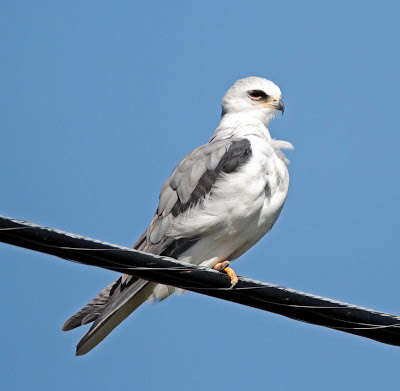I hope everyone had a wonderful Thanksgiving last weekend.
The majority of the fall migrants have passed through. However, a number of warbler species do winter over in limited numbers, according to the Checklist of Birds of the Upper Texas Coast.
The common winter resident warblers are Myrtle, Orange-crowned and Pine. So it is always fun to find some other species that are either very late migrants, or birds that have decided to go no further south.
Here is an
Ovenbird that I found by the drip at LaFitte's Cove in Galveston on Oct 26th.
 |
| Ovenbird |
And here is a
Black-throated Green Warbler from Thanksgiving weekend.
 |
| Black-throated Green Warbler |
This beautiful female Summer Tanager was also seen on Oct 26. According to the checklist, a few of this species also winter over here.
 |
Summer Tanager - female
|
That same day also produced my first pair
Lark Sparrows at LaFitte's Cove in Galveston. The distinctive facial pattern make this sparrow an easy ID.
 |
| Lark Sparrow |
The
White-tailed Kite (
Elanus leucurus) is a beautiful all white raptor with black shoulder patches. I had been told about a pair of these birds nesting along Stewart Road in Galveston in a dead tree. It was difficult to get any photos of the birds on the nest as they sat very low down in the nest. Last weekend, the 3 babies had fledged. the family group of 5 birds were in the tree and 2 were on the wires beside the road. I stopped my car and took photos out of the car window. Using the car as a blind in this fashion doesn't disturb the birds like getting out of the car would.
Here is one of the adults. It is all white with a gray back and black shoulder patches.
 |
| White-tailed Kite - adult |
This was the first time that I had seen and photographed the juvenile plumage. They are washed on the head, breast and back with reddish brown.
 |
| White-tailed Kite - juvenile |
Later I found another juvenile eating lunch on top of a post. The diet of these birds is insects and small rodents. Also notice on these juveniles, that the wing feathers are all edged in white.
 |
| White-tailed Kite - juvenile eating rodent |
Now, what about that quiz bird form the last bulletin. Here it is again, a Yellow-throated Vireo.
 |
| Yellow-throated Vireo |
The question was a missing field mark and why. I had a few people makes some guesses, but no one got the answer as to what was missing.
Here is a photo of another vireo.
 |
| Warbling Vireo |
The field mark that isn't visible is the hook on the upper mandible. The beak is the differenting field mark of vireos from warblers. Warblers have thinner straight beaks. The vireos have thicker beaks and the upper mandible is hooked at the end.
Notice in the photo that the upper mandible of the quiz bird doesn't reach to the end of the lower mandible and the hook is not visible.
Why? I think the bird has a beak deformity. Here is a photo of the same bird head on and you can see the upper mandible is bent to the right. The hook is visible here and it almost looks like a crossbill.
 |
| Yellow-throated Vireo |
I was interested in this phenomenon, as there had been an article in Birding magazine several years ago about beak deformities in Black-capped Chickadees in Alaska. I did a Google search for beak deformities and the only reference was the chickadees. So I guess it is a rare occurrence. I was pleased to get a photo of it. I only noticed it after getting home and looking at the photos on the computer and I knew something was wrong with the beak., Fortunately, I had a number of photos and could ascertain the problem. Thanks to those who took the time to send in their answers.
Happy birding and photography,
David
McDonald
dkmmdpa@gmail.com
photos copyright 2012 David McDonald
To have these trip reports sent to your email, please
email me at the above address and ask to subscribe.




















































